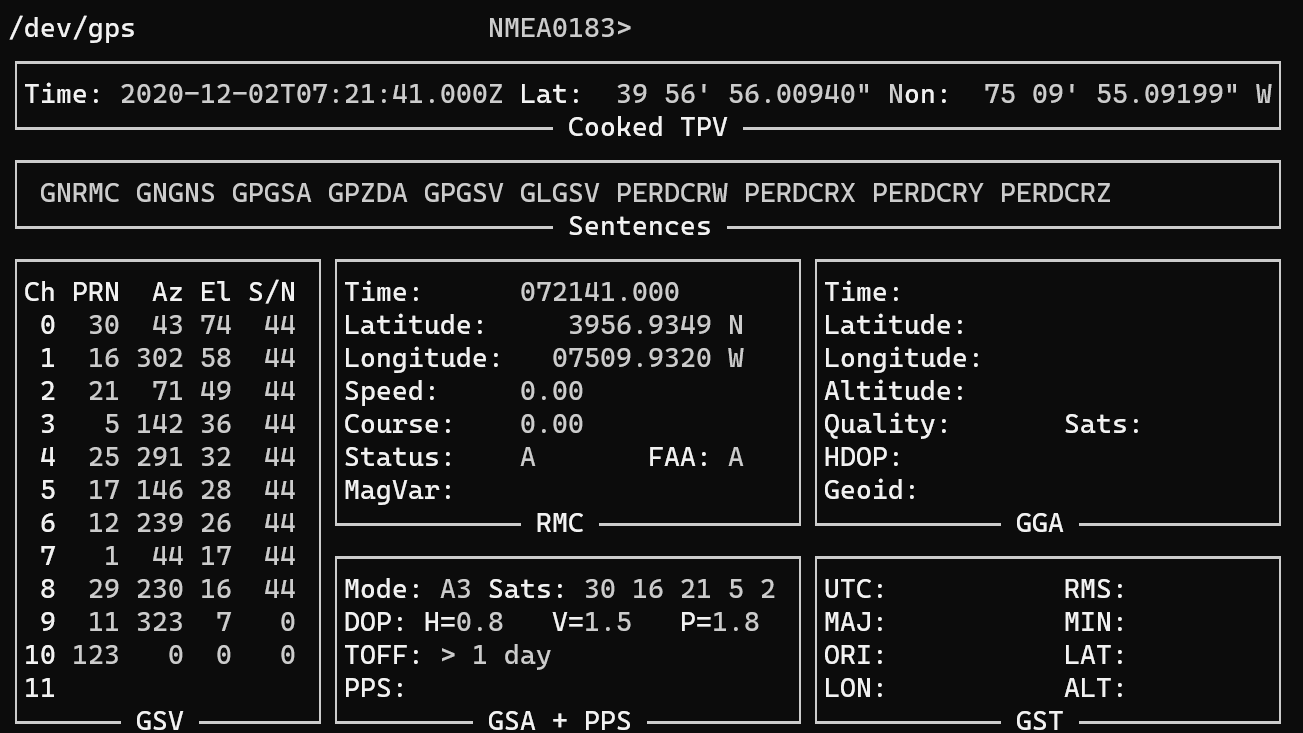Edge Series GNSS Guide¶
The Edge Series AIR-T product line is equipped with an premium, industrial grade global navigation satellite system (GNSS) receiver that is capable of operation over the product's full temperature range of -40°C to +85°C. The GNSS receiver is accompanied by an atomic clock class stability disciplined oscillator with 24 hour holdover performance comparable to Rubidium and has anti-jam performance against continuous wave signals. This section of the product guide covers the specifics of the GNNS-DO on the AIR-T Edge Series.
| Parameter | Value |
|---|---|
| Connector Type | MCX |
| Crystal Oscillator | OCXO |
| Antenna | Active (5V compatible) or Passive |
| 1 PPS Accuracy | 40 ns to UTC |
| Holdover Stability | <±400nsec @ 1 hour <±50usec @ 24 hours |
| GNSS Reception Capability | GPS L1C/A, GLONASS L1OF, Galileo E1B/E1C, QZSS L1C/A, QZSS L1S, SBAS L1C/A |
| Anti-jam | Eight automatic anti-jam countermeasures against CW signals |
Receiver Performance¶
| Parameter | GPS | GLONASS | Galileo | QZSS | QZSS | SBAS |
|---|---|---|---|---|---|---|
| Signal type | L1C/A | L1OF | E1B/E1C | L1C/A | L1S | L1C/A |
| Channels | 12 | 10 | 8 | 4 | 2 | 2 |
| Hot acq. sensitivity (dBm) | > -162 | > -158 | > -136 | > -136 | - | - |
| Cold acq. sensitivity (dBm) | > -148 | > -144 | > -136 | > -131 | > -130 | > -130 |
| Tracking sensitivity (dBm) | > -162 | > -158 | > -146 | > -147 | > -134 | > -139 |
| Re-acq. sensitivity (dBm) | > -162 | > -158 | > -136 | > -136 | > -130 | > -130 |
Electronic Protection Against Interference and Jamming¶
The GNSS receiver on the Edge Series AIR-T is capable of mitigating the negative impact of jamming signals. If a continuous wave (CW) jamming signal is detected, the receiver has eight anti-jam functions to mitigate the effects and maintain lock.
1PPS Performance¶
| Parameter | Locked | Holdover (< 1 hour) | Holdover (< 24 hours) |
|---|---|---|---|
| 1PPS Accuracy | < 40 ns | < ± 400 ns | < ± 5.0 μs |
| 1PPS Stability (1-σ) | < 4.5 ns | - | - |
Oscillator Performance¶
| Parameter | Locked | Holdover (< 24 hours) |
|---|---|---|
| Short Term (Root Allan Variance, T=1s) | < 10-11 | - |
| Long Term (24-hour average) | < 10-12 | < 10-10 |
| Frequency Offset | Phase Noise |
|---|---|
| 1 Hz | < -90 dBc/Hz |
| 10 Hz | < -120 dBc/Hz |
| 100 Hz | < -135 dBc/Hz |
| 1,000 Hz | < -145 dBc/Hz |
| 10,000 Hz | < -145 dBc/Hz |
Antenna Selection¶
Table 6 below outlines the recommended antennas for the supported GNSS signal types. The voltage to power the antenna pre-amplifier is superimposed (biased) on the antenna connector. In a deployment where multiple Edge Series radios are needed, only a single GNSS antenna is necessary. In this situation, the system has a preventative function to stop current backflow.
| Parameter | Value | Note |
|---|---|---|
| GPS/QZSS Center Frequency | 1,575.42 MHz | 2.046 MHz bandwidth |
| GLONASS Center Frequency | 1,602 MHz | 9 MHz bandwidth |
| Galileo Center Frequency | 1,575.42 MHz | 4.092 MHz bandwidth |
| Antenna Gain | 0 dBi (min) | |
| Preamplifier Gain | 15 to 35 dB | Including cable loss |
| Preamplifier NF | 3.5 dB (max) | |
| Impedance | 50 Ohms | |
| VSWR | 2 |
Software Interface¶
GPSd Interface¶
AirStack provides software support for the GNSS disciplined oscillator via the GPSd service daemon. This allows for the AIR-T to leverage the system for position, Network Time Protocol (NTP), and many other common features for GPS.
GPSd Documentation¶
A full list of the GPSd manual pages that describe the operation may be found here. For example, to dump the raw NEMA message to the terminal screen, use the command:
$ gpspipe -r
To view the GPS data stream output in a table, use the command
$ gpsmon

GNSSDO as the Reference¶
The SoapyAIRT driver in AirStack can easily leverage the GNSS disciplined oscillator as a frequency reference. This may be done by setting the clock source to GPS using the setClockSource method:
sdr = SoapySDR.Device(dict(driver="SoapyAIRT"))
try:
sdr.setClockSource("GPS")
except RuntimeError as e:
print("GPS Clock Reference Failed!")
print(e)
sdr.setClockSource("internal")
For more information, see the External Clock Reference application note.